![]()
![]()
![]()
Use LEFT and RIGHT arrow keys to navigate between flashcards;
Use UP and DOWN arrow keys to flip the card;
H to show hint;
A reads text to speech;
8 Cards in this Set
- Front
- Back
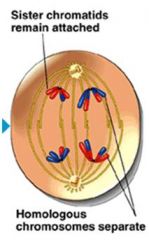
|
Sexual Reproduction – requires fertilization (one sex cell from each parent joins together)Sexual Reproduction – requires fertilization (one sex cell from each parent joins together)
Division of a parent cell (diploid) into four daughter cells, called “gametes” (haploid – half a set of chromosome), with different genetic information Occurs in germ cells (sex cell – egg, sperm) for producing offspring (new organisms) Meiosis I: Prophase I, Metaphase I, Anaphase I, Telophase & Cytokinesis I Meiosis II: Prophase II, Metaphase II, Anaphase II, Telophase & Cytokinesis II |
|
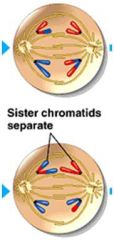
|
Chromosomes form and each chromosome pairs with its homologous chromosome; called a tetrad – four chromatids
In a tetrad, homologous chromosomes can exchange portions of their chromatids; called crossing-over Occurs at the chiasma Creates recombinant chromatids (“recombined”) Provides genetic variation – that’s how each one of us is very different from the other Sexual reproduction creates genetic variation |
|
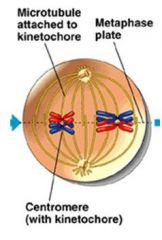
|
Chromosomes form and each chromosome pairs with its homologous chromosome; called a tetrad – four chromatids
In a tetrad, homologous chromosomes can exchange portions of their chromatids; called crossing-over Occurs at the chiasma Creates recombinant chromatids (“recombined”) Provides genetic variation – that’s how each one of us is very different from the other Sexual reproduction creates genetic variation |
|
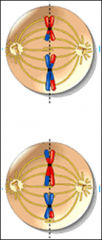
|
Tetrads line up in the middle, equatorial plane, of the cell
|
|
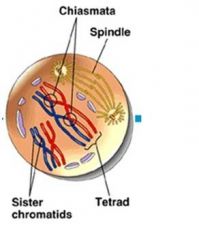
|
Homologous chromosomes separate and move away from each other to opposite poles of the cell
Each is genetically different from the original cell due to crossing-over |
|
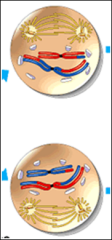
|
Nondisjunction can occur when homologous chromosomes do not separate during anaphase I
There is an uneven distribution of chromosome to the two daughter cells, which may result in one daughter cell not having any chromosomes at all At this stage, there is a higher risk of producing nonviable cells (not able to reproduce) during meiosis II Genetic mutations in meiosis CAN be passed to offsprings |
|
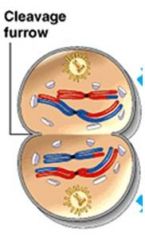
|
Sister “recombinant” chromatids are separated into four gamete cells
Follows stages similar to Mitosis |
|

|
Chromosomes form
Nuclear envelope disappears |

